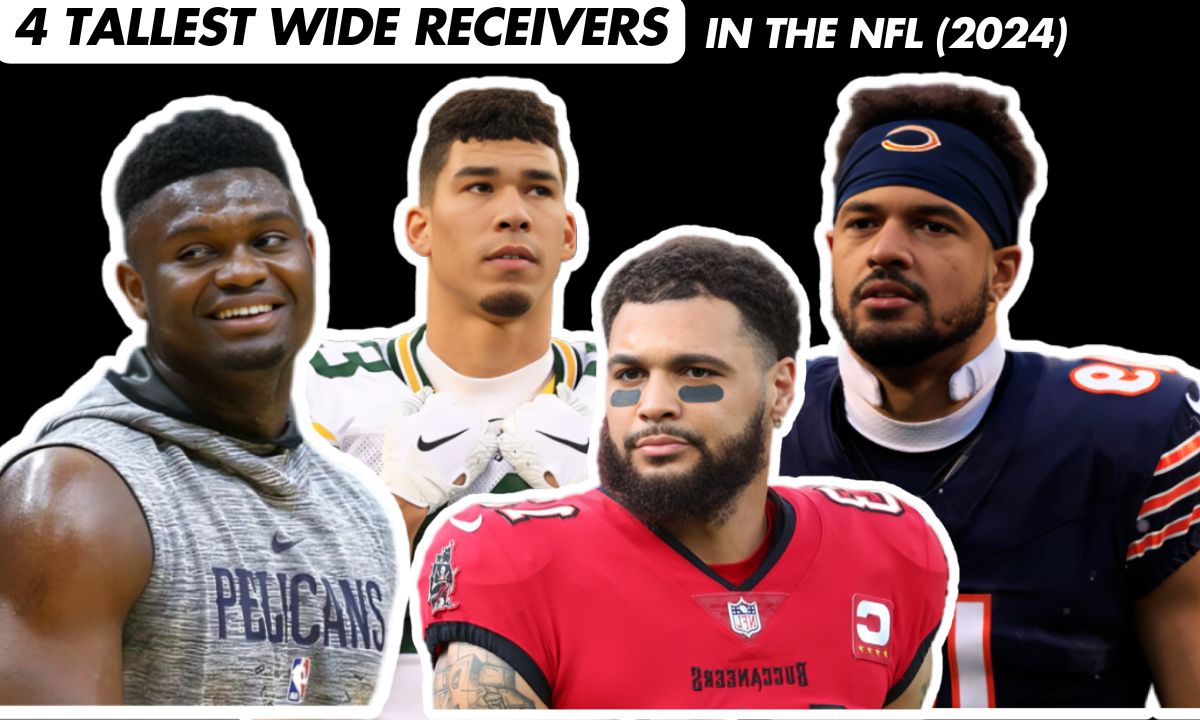In today’s NFL, where every physical advantage counts, height has become an increasingly valuable asset for wide receivers. These towering talents bring unique capabilities to the field, creating matchup nightmares for defensive coordinators and exciting opportunities for offensive strategists. Let’s dive into the world of the NFL’s most imposing pass catchers and explore how they’re changing the game.
The Fantastic Four: Meet the 6’5″ Giants
The NFL’s current roster of tall receivers features an elite group of athletes who combine exceptional height with remarkable skill. These towering wideouts have redefined what’s possible at the position, bringing a blend of physicality and finesse that’s revolutionizing offensive strategies.
Mike Evans: Tampa Bay’s Touchdown Machine
Mike Evans stands as the epitome of consistency among tall NFL players. Since joining the Buccaneers in 2014, he’s achieved an unprecedented feat: ten consecutive 1,000+ yard seasons, a milestone that speaks volumes about his durability and dominance.
Standing at 6’5″ and weighing 231 pounds, Evans brings a unique combination of size and athleticism that’s made him one of the most reliable red zone targets in NFL history. His career statistics tell a compelling story:
| Category | Stats |
| Career Receptions | 762+ |
| Touchdown Catches | 94+ |
| Yards Per Catch | 14.8 |
| Pro Bowl Selections | 4 |
“Mike’s ability to high-point the football is unprecedented. He’s got the best catch radius I’ve ever seen.” – Bruce Arians, former Buccaneers head coach
Allen Lazard: New York’s Undrafted Gem
The journey of Allen Lazard from undrafted prospect to NFL standout embodies perseverance. At 6’5″ and 227 pounds, Lazard has developed into a reliable target and exceptional blocker for the New York Jets. His path through the NFL showcases the value of determination and continuous improvement.
Key strengths of Lazard’s game include:
- Elite blocking ability for a receiver
- Strong hands in traffic
- Exceptional red zone presence
- Versatility in route running
- Leadership qualities
Equanimeous St. Brown: Chicago’s Athletic Marvel
Coming from an incredibly athletic family, Equanimeous St. Brown brings a unique blend of size and speed to the Bears’ offense. At 6’5″, his combination of height and athleticism makes him a constant deep threat and valuable asset in Chicago’s developing passing game.
Notable achievements include:
- Multiple 100+ yard receiving games
- Exceptional yards per catch average
- Strong blocking grades
- Versatility in multiple offensive schemes
A.T. Perry: New Orleans’ Rookie Sensation
A.T. Perry represents the future of tall receivers in the NFL. The Saints’ rookie has already shown flashes of brilliance that suggest a bright future. His 6’5″ frame combined with exceptional body control makes him a promising prospect in New Orleans’ offensive system.
The Height Advantage: Towering Over the Competition
Being tall fundamentally changes how receivers play the game. These towering athletes create mismatches against shorter defensive backs, especially in the red zone where their catch radius becomes a game-changer.
A 6’5″ receiver can effectively box out defenders like a basketball player, using their body to shield the ball while making catches that shorter players simply can’t reach.
This height advantage particularly shines in jump-ball situations and when quarterbacks need to throw the ball where only their receiver can get it.
The advantages of being a tall receiver in the NFL extend beyond just catching passes. These athletes impact the game in multiple ways:
- Red Zone Effectiveness
- Higher success rate in contested catches
- Larger catch radius for quarterbacks
- Better visibility over defenders
- Increased touchdown potential
- Blocking Advantages
- Better leverage against defenders
- Improved effectiveness in run blocking
- Superior screen game contribution
Challenges and Adaptations
Despite their advantages, tall receivers must overcome unique challenges. Their longer frames can make quick direction changes more difficult, requiring extra work on agility and footwork. Many tall receivers spend countless hours perfecting their route-running technique to match the sharpness of shorter, naturally quicker receivers.
They also face a higher risk of lower-body injuries due to their size, making specialized training and injury prevention crucial to their longevity in the league.
Despite their advantages, tall receivers face unique challenges:
- Speed and Agility Requirements
- Route Running Precision
- Injury Prevention
- Center of Gravity Management
The Future of Tall Receivers in the NFL
The NFL’s evolution suggests an increasing role for tall receivers. Teams are actively seeking these physical specimens who can create mismatches, particularly as defenses get faster and more sophisticated. College programs are developing more tall receivers who combine size with speed and agility, suggesting we’ll see even more impact from towering receivers in coming years.
The success of players like Mike Evans has created a blueprint for how teams can effectively utilize tall receivers, making them highly valued assets in both the draft and free agency.
The evolution of the NFL offense continues to create opportunities for tall receivers. Modern offensive strategies increasingly emphasize:
- Matchup-based game planning
- Red zone efficiency
- Vertical passing concepts
- Position versatility
- Size-speed combinations
Conclusion
The impact of tall receivers on the NFL continues to grow. From Mike Evans’ consistency to A.T. Perry’s promising future, these towering talents demonstrate that height, when combined with skill and dedication, creates extraordinary opportunities in professional football. As the game evolves, expect to see more emphasis on finding and developing receivers who can literally rise above the competition.
The success of these four giants proves that in the NFL, sometimes the best way to get ahead is to simply reach higher than everyone else.
FAQ’s
Who is the tallest wide receiver in NFL history?
Harold Carmichael, at 6’8″, holds this record. He played for the Eagles and Cowboys, earning four Pro Bowl selections during his career.
Do tall receivers have longer careers in the NFL?
No direct link exists between height and career length. Success depends on durability, skills, and adaptability rather than height alone.
How do teams defend against extremely tall wide receivers?
Teams typically use double coverage, physical press coverage, and safety help over the top. They also try matching them with their tallest defensive backs when possible.
Are there any disadvantages to being a tall wide receiver?
Yes – slower acceleration, tougher time making quick cuts, higher injury risk to lower body, and more difficulty staying low in routes.
Which NFL team has the tallest receiving corps on average?
The Tennessee Titans currently field one of the tallest receiving groups, though this constantly changes with roster moves throughout the season.

